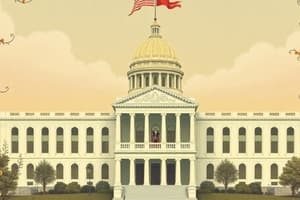Podcast
Questions and Answers
What is one of the primary powers of the legislative branch?
What is one of the primary powers of the legislative branch?
- Vetoing legislation
- Judicial appointments
- Oversight (correct)
- Creating budgets
The executive branch has the power to influence legislative actions through the veto.
The executive branch has the power to influence legislative actions through the veto.
True (A)
What is the primary role of the SEC?
What is the primary role of the SEC?
To regulate securities markets and protect investors.
The _____ clause gives Congress the power to regulate commerce with foreign nations, among the several states, and with Indian tribes.
The _____ clause gives Congress the power to regulate commerce with foreign nations, among the several states, and with Indian tribes.
Match the following Supreme Court cases with their significance.
Match the following Supreme Court cases with their significance.
Flashcards
Legislative Power
Legislative Power
The power of the legislative branch to create laws, oversee the executive, and approve budgets.
Executive Power
Executive Power
The power to enforce laws proposed by the legislative branch and to set the agenda.
Judicial Appointment
Judicial Appointment
The process of the President nominating and the Senate confirming judges to federal courts.
Checks and Balances
Checks and Balances
Signup and view all the flashcards
Commerce Clause
Commerce Clause
Signup and view all the flashcards
Study Notes
Legislative Branch
- Powers: Oversight, controlling the budget (purse), making laws (legislation)
- Committee Structure/Appointed Positions: Often polarized (divided)
- Spending/Legislation: Pork-barrel spending (projects benefiting specific districts) and representative models of legislation
- Checks on Other Branches: Checks on executive and judicial powers through the court system; Article I outlines these powers
- Commerce Clause: Legally allows Congress to regulate commerce
- Confirmation: Process of approving presidential appointments
- Bill Passing Process: Detailed steps for passing laws through the House and Senate
- Leadership Roles: Specific leadership roles in the House and Senate
Executive Branch
- Budget Creation: Plays a key role in creating the budget
- Veto Power: The power to reject legislation
- Presidential Honeymoon Period: Initial high approval period for a new president
- Checks on Other Branches: The executive branch checks the judicial and legislative branches
- Communication: Communication methods such as the "bully pulpit," signing statements, and open communications; Article II outlines powers
- Nomination Power: Power to nominate individuals to various positions
- Five Roles: Five key roles of the executive branch should be noted
- Formal/Informal Powers: Both formal and informal powers impact the executive branch
Bureaucracy
- Delegated Powers: Discretionary authority given to agencies
- Rule-Making Authority: Power to create rules and regulations
- Regulation: Enforces regulations and controls the bureaucracy
- Iron Triangle: Interplay between bureaucracy, interest groups, and legislators
- Civil Liberties vs. Business: Conflicts between civil liberties and private property interests
Judicial Branch
- Appointments & Tenure: Appointment of judges and their terms of service
- Checks on Other Branches: Checks on both executive and legislative branches; Article III details powers
- Legal Terms: Precedent (following prior decisions) and legitimacy crisis are important terms
- Supreme Court Role: The Supreme Court's role as the highest court
- SCOTUS Cases/Documents: Landmark SCOTUS cases and documents like Baker v. Carr, Federalist 51, Federalist 78, Shaw v. Reno, and Marbury v. Madison
- Concepts: Different applications of the above principles
Concept Applications
- SEC (Securities and Exchange Commission): Regulates the securities industry, appointed by the president
- FAA (Federal Aviation Administration): Regulates air travel, appointed by the president
- FDA (Food and Drug Administration): Regulates food and drugs, appointed by the president
- First Step Act: Legislation related to criminal justice reform; method of passage should be noted
Studying That Suits You
Use AI to generate personalized quizzes and flashcards to suit your learning preferences.




